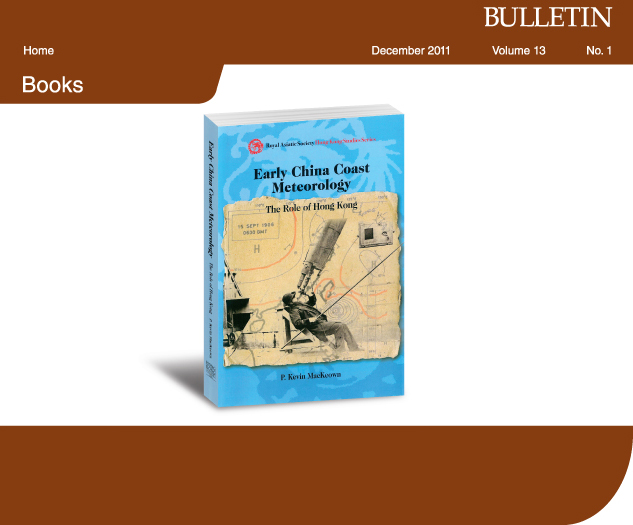
|
“Despite the antagonism between |
|||
Professor P. Kevin MacKeown |
|||
There can be few places in the world where people have such a close attachment to their Observatory than in Hong Kong. While overseas, people look to television for their weather news, here we tend to go straight to the source: the Hong Kong Observatory for our daily update on rain warnings, humidity levels and of course the approach of a typhoon. P. Kevin MacKeown's book Early China Coast Meteorology: The Role of Hong Kong is a perceptive account of the Observatory's early years and a fascinating work not only from a meteorological point of view but also as a reflection of early colonial Hong Kong. Professor MacKeown does not have a background in meteorology - his career has been in physics. Indeed, he set out initially to write a history of physics, but while researching that book came across the interesting character of William Doberck, the first Director of the Hong Kong Observatory, and realized that here was a story to tell. Doberck helmed the newly set up Hong Kong Observatory for 24 years, from 1883 until 1907. A Danish professor whose real interest lay in astronomy, Doberck's career in Hong Kong – perhaps appropriately considering the job – was stormy. Few records "It was as much because of what had not been written about him as what had that interested me," says Professor MacKeown. "He ran the Hong Kong Observatory for 24 years, yet there was very little known about him, very few records. I found that interesting, and the more I researched the more interesting this rather cantankerous character became." He initially wrote an article on Doberck in 2004, then decided to expand it into the book. It is aimed at people with an interest in Hong Kong's colonial history during its formative years, and in the history of the region. Indeed the book is of far more general interest than the title might suggest. Born in Copenhagen in 1852, Doberck was awarded a doctorate for his thesis on research into comets in 1873. He then moved to County Sligo in Ireland to work at the Markree Observatory, home of the largest telescope ever made at the time. By the time he was appointed to the role of Director of the fledgling Hong Kong Observatory in 1883, Doberck was an accomplished astronomer with at least 98 publications to his name. And there's the rub: His main interest was astronomy not meteorology. As he would later point out in his strained exchanges with the HK Governor, no mention was made in the original job description of weather-forecasting. This began his erratic relationship with various governors, in particular Governor Sir Matthew Nathan, as well as with his colleagues, the commercial community and his peers at the Jesuit observatories in Manila and Shanghai, with whom he was instructed to work, but chose to ignore. "Despite the antagonism between Doberck and the other observatories, they did manage to develop a storm warning system, as well as make valuable strides in the study and forecasting of typhoons," says Professor MacKeown. Devastating typhoon Not that the forecasts always came – on the morning of September 18, 1906 Hong Kong was struck with its most devastating typhoon on record. "The first storm warning went up at 8am, but before any evasive action could be taken the storm had swept down on the colony and by 11am it was all over." More than 10,000 people lost their lives, countless ships were destroyed. Governor Nathan called it "a catastrophe as calamitous, if not more, than any which has previously befallen the Colony." |
|||
There followed much controversy over whether Zikawei Observatory in Shanghai had warned Hong Kong of the storm's approach, and been ignored. Or whether the typhoon had in fact taken everyone by surprise. Professor MacKeown concludes no warning was given, but that given Doberck's penchant for ignoring Zikawei, speculation was bound to be rife. "Without Doberck, the observatory's early years would undoubtedly have been very different, and perhaps meteorologically better off – that was not his area of interest," says Professor MacKeown. "On the other hand, he left it a highly professional entity – just not a very user-friendly one. He also stood up for the Observatory over the years, refusing to capitulate to requests for financial cuts." Researching the book he scoured archives, public records and the Internet. His research also brought up findings of a most unscientific nature, including a possible relationship between Doberck's sister Anna, who worked with him in Hong Kong for many years, and the Governor Nathan. As Professor MacKeown muses, " 'Anna and the Governor . . .' but we will forfeit the movie rights and move on." Historians of science will find much of interest in this colourful work. The early study of typhoons is particularly important, as well as the first attempts at quantitative meteorology. This is also the only written history of the workings of the Zikawei Observatory (now only a library remains) in Shanghai and the Manila Observatory, whose records were largely destroyed at the end of World War II. Early China Coast Meteorology: The Role of Hong Kong is published by Hong Kong Universtiy Press. |
|
| Next | ||